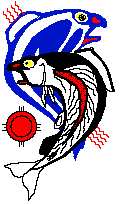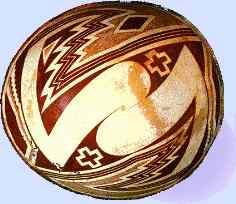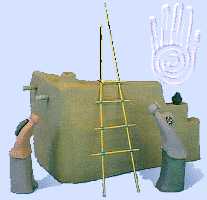



 --Page Buttons
--Page Buttons|
Mata Ortiz--A Mexican Village of Potters --A small (2,000 pop.) village in northern Chihuahua 100 miles south of New Mexico has almost everyone making pots for the souvenir trade. In the 1930's, as a boy, elder Juan Quezada rediscovered methods used by the villagers' ancestors, the Paquimè Indians (who lived there 900 years ago). As his pots began to sell, he taught others -- traditionalists, innovators. Interviews and photos with villagers form a fascinating story of life in this little town, which had no pottery tradition whatever -- it was created from potsherds. Webmaster Mike Williams has been a friend for a long time obviously, publishes a newsletter for Friends of Maya Ortiz.
Books about Mata Ortiz pottery available from Amazon.com. Subscribe to: American Indian Art Magazine
 Hollister Collection of Southwestern Native American Pottery--This is what every museum should be doing: a scholarly presentation of collections for on-line study. Most are just running heavily-textual PR for themselves, with occasional photos and a few nice on-line virtual galleries. The 94 pots are accessed through several criteria link-lists, all leading to a page that has a pic of the pot, attribution, date, and potter (if known). Most of these pots (which include a lot of blackware, and 3 examples -- like the one shown at the right -- by Maria, who re-discovered the technique) are traditional useful objects, from bean pots to water ollas to wedding vases -- with the occasional sleek ashtray. If the pages provided more info about who's who and where the collection is, it's possible southwestern Pueblo families might be able to help ID pots with marks or first-names. These pots appear to have been collected in the 1920's - '40's, Collection on University of Massachusetts campus somewhere; study catalog here is still under construction with much yet to be done. Exemplary beginning. Hollister Collection of Southwestern Native American Pottery--This is what every museum should be doing: a scholarly presentation of collections for on-line study. Most are just running heavily-textual PR for themselves, with occasional photos and a few nice on-line virtual galleries. The 94 pots are accessed through several criteria link-lists, all leading to a page that has a pic of the pot, attribution, date, and potter (if known). Most of these pots (which include a lot of blackware, and 3 examples -- like the one shown at the right -- by Maria, who re-discovered the technique) are traditional useful objects, from bean pots to water ollas to wedding vases -- with the occasional sleek ashtray. If the pages provided more info about who's who and where the collection is, it's possible southwestern Pueblo families might be able to help ID pots with marks or first-names. These pots appear to have been collected in the 1920's - '40's, Collection on University of Massachusetts campus somewhere; study catalog here is still under construction with much yet to be done. Exemplary beginning.
 Nora Naranjo-Morse, Santa Clara Pueblo --This links to excerpts from this clay sculptor's book of poetry, Mud Woman: Poems from the Clay, 1991, University of Arizona Press, $15.95 paperback, 800/426-3797. Her book is illustrated with photos of her clay sculpture. In the long intro essay, she describes her life and art, as an Indian woman artist who faced difficulties with non-traditional work such as caricatures of grotesque white tourists . She also tells how she derived strength and inspiration from her mother and the tradition of Santa Clara Pueblo pottery. The essay links to some of Nora's poems, which are illustrated with small clickbuttons that link to extra-large high-quality photos of all too few of her amazing, sometimes funny, clay sculptures. The 127-page book itself has 30 color plates, some humorous, some more traditional. Some of the funny ones are caricatures of tourists and other obnoxious white people, that are sort of like Koshare clowns in a way, if clowns wore gold spandex tights and floppy lady hats and sequin sunglasses.. Nora's poems are very fine. They speak strongly to all women everywhere, but especially to those of us who are walking various knife-edges between modern life and traditional values.Nora's book is very highly recommended for classroom reading (7+ grades) and for gifts, especially for women and girls. Possibly certain really sensitive (as they describe themselves) Significant Other male types if you think they could handle it. Personally I think it would be wasted on most men, so give it to them, then steal it back when they leave it lying around untouched. There is a hardcover version also, $35. They take telephone credit card orders, and school purchase orders. The book excerpts are prepred by Karen Strom, part of her experimental on-line multimedia book project.
Books by Nora Naranjo-Morse available from Amazon.com.
PAGE LOGO BOWL is Mimbres, around 1300-1450. Mimbres pottery, named after the Mimbres Valley of Mexico, was a product of the Mogollon culture, which began to cultuvate corn in the dry highlands of Mexico-New Mexico-Arizona around 2,000 BC. Mimbres pottery was made by the coil technique. The earliest examples -- from about 200 - 700 AD -- are delicate designs of black on white, some geometric abstracts, but many geometrized animal or spirit-figures. Later, polychrome pottery (like this) using red and black glazes was made. The amazing geometric designs have had much influence on Indian art of the southwest, as can be seen from many items in the pottery galleries here. This bowl is from the collection of the Dallas Museum of Art. Juan Quesada photo by Mike Williams, Webmaster of the Mata Ortiz village site. Maria Martinez (Poveka) (San Ildefonso Pueblo, 1881-1980) blackware pot, 1923. Maria rediscovered the ancient technique of airless firing to make blackware. Her husband Julian invented a method of decorating pots with matte black designs on shiny black. Her entrepreneur son Popovi Da also began self-marketing, partly cutting out the traditional southwest system of non-Indian "trading post" middlemen who took most of the profits from sales, though this still survives in a host of classy, profitable (to the owners) fine arts galleries in Santa Fe and Albuquerque. Towa (the People) clay sculpture by Nora Naranjo-Morse, photo from her Mud Woman book. Why?, Roxanne Swentzell, Santa Clara Pueblo, life-size ceramic sculpture from Alan Houser Memorial Sculpture Graden, Phoenix, AZ. One of the most powerful pieces of art done by anyone, anywhere, anytime, anyculture. Fantastic Owl, by Mike & Jackie Torivio, Acoma Pueblo husband-wife potter team. Is this one in the Heard Museum or in Karen Strom's personal collection? Very loveable to someone like me who loves owls. Books about Pueblo pottery available from Amazon.com. Books about Mata Ortiz pottery available from Amazon.com. Subscribe to |
|---|

Custom Search
|
Page |
MENU |
MENU |
|---|
Webmistress Paula Giese -- Explanatory text and graphics copyright 1995.
Last Updated: 5/27/97